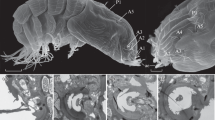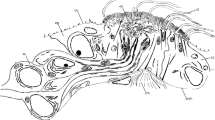Summary
Fine-structure studies of the sensory receptors of Aglantha digitale have been done by transmission- and scanning-electron microscopy. Aglantha has 8 club-shaped statocysts and three types of ciliated sensory receptors: ciliated comb pads, ciliated sensory cells with microvilli, and ciliated sensory cells without microvilli. The epithelium covering the statocyst has both ciliated sensory cells and epitheliomuscular cells. The ciliated comb pads are formed by a group of ciliated sensory cells, each having an apical kinocilium surrounded by a ring of microvilli. These microvilli show an increase in length towards the velum. The axons from the comb pad cells enter the inner nerve ring. The structure, function and the evolution of the statocysts and the possible role of the ciliated comb pads and other sensory receptors are discussed.
Similar content being viewed by others
References
Donaldson S, Mackie GO, Roberts A (1980) Preliminary observations on escape swimming and giant neurons in Aglantha digitale (Hydromedusae: Trachylina). Can J Zool 58:549–552
Flock A (1971) Sensory transduction in hair cells. In: WR Loewenstein (ed) Handbook of sensory physiology. Vol 1. Springer, Berlin Heidelberg Ney York
Hertwig O, Hertwig R (1878) Das Nervensystem und die Sinnesorgane der Medusen. Vogel, Leipzig
Horridge GA (1969) Statocysts of medusae and evolution of stereocilia. Tissue and Cell 1:341–354
Joseph H (1920) Über einen mutmaßlichen Primitivzustand eines Schweresinnes-Organes. Verh Zool Bot Ges Wien Jahrg 1919 Bd 69:27–34
Mackie GO (1975) Neurobiology of Stomotoca II Pacemakers and conduction pathways. J Neurobiol 6:357–378
Mackie GO (1980) Slow swimming and cyclical ‘fishing’ behavior in Aglantha digitale (Hydromedusae: Trachylina). Can J Fish Aquat Sci 37:1550–1556
Müller OF (1776) Zoologiae Daniae prodromus seu animalium Daniae et Norvegiae indigenarum characteres nomina et synonma. Hauniae, pp 233
Roberts A, Mackie GO (1980) The giant axon escape system of hydrozoan medusa Aglantha digitale. J Exp Biol 84:303–318
Singla CL (1972) Sense organs of hydromedusae. PhD thesis. University of Victoria, Victoria, B C, Canada
Singla CL (1975) Statocysts of hydromedusae. Cell Tissue Res 158:391–407
Singla CL (1978) Locomotion and neuromuscular system of Aglantha digitale. Cell Tissue Res 188: 317–327
Tardent P, Schmidt V (1972) Ultrastructure of mechanoreceptors of the polyp Coryne pintneri (Hydrozoa, Athecata). Exp Cell Res 72:265–275
Author information
Authors and Affiliations
Additional information
I am grateful to Dr. D. Paul for critical reading of the manuscript. This work was supported by NSERC operating grant No. A1427 to Dr. G.O. Mackie
Rights and permissions
About this article
Cite this article
Singla, C.L. Fine structure of the sensory receptors of Aglantha digitale (Hydromedusae: Trachylina). Cell Tissue Res. 231, 415–425 (1983). https://doi.org/10.1007/BF00222191
Accepted:
Issue Date:
DOI: https://doi.org/10.1007/BF00222191




